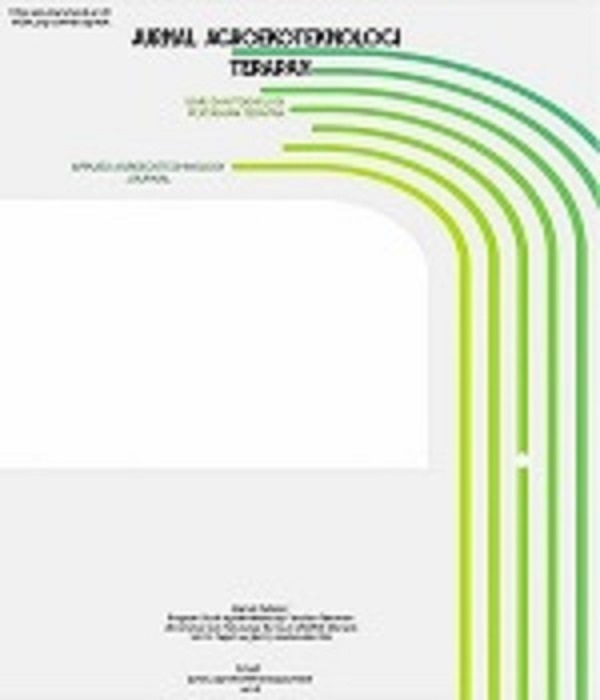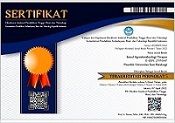Formulation Of Dragon Fruit (Hylocereus polyrhizus) With Yellow Sweet Potato (Ipomoea batatas L.) Puree And Goroho Banana (Musa acuminafe, sp) Puree In Making Yoghurt
DOI:
https://doi.org/10.35791/jat.v5i1.55424Keywords:
yogurt, red dragon fruit, yellow sweet potato, goroho banana, antioxidant activity, probioticAbstract
In the era of functional food innovation, foods containing probiotics such as yogurt are known to offer significant health benefits to humans, not only in maintaining gut microbial balance but also in preventing various chronic degenerative diseases. This study aims to develop a functional beverage based on yogurt by incorporating red dragon fruit, yellow sweet potato, and goroho banana. This research employed a Completely Randomized Design (CRD) method with nine different treatments and three replications for each treatment. The parameters tested for their effects in this study were antioxidant activity, acidity level (pH value), and viscosity of the yogurt. The results of this study indicated that the best treatment for the formulation of dragon fruit yogurt, yellow sweet potato puree, and goroho banana puree was found in treatment A (Dragon Fruit Yogurt 100%) with antioxidant activity concentrations of 0.4 mg/g, 0.8 mg/g, 2.0 mg/g, 3.2 mg/g, 4.0 mg/g, and 4.8 mg/g, which were sequentially 22.76%, 40.97%, 61.31%, 76.48%, 86.34%, and 90.90% with an IC50 value of 0.67%. The acidity level (pH) was 3.28, and the viscosity was 4.75 cP.
Keywords: yogurt, red dragon fruit, yellow sweet potato, goroho banana, antioxidant activity, probiotic
References
Agustina, Y., Kartika, R., & Panggabean, A. S. 2015. “Pengaruh Variasi Waktu Fermentasi terhadap Kadar Laktosa, Lemak, pH dan Keasaman pada Susu Sapi yang Difermentasi Menjadi Yogurt” dalam Jurnal Kimia Mulawarman, 12(2): 97-100.
Badan Standardisasi Nasional. 2009. SNI 2981:2009 Yogurt. Standar Nasional Indonesia, 2981, 1–51.
Destinugrainy Pauline Kasi, Ariandi, Heni Mutmainnah. 2017. “Uji Antibakteri Isolat Bakteri Asam Laktat yang Diisolasi dari Limbah Cair Sagu Terhadap Bakteri Patogen” dalam Biotropika : Journal of Tropical Biology. 5 (3).
Emmawati, A., Sri, B., et al. 2015. “Characterization of Lactic Acid Bacteria Isolates from Mandai Function as Probiotic” dalam Agritech. 35 (2), pp. 146-155.
Jannah, A.M., Nurwantoro, N., & Pramono, Y.B. 2012. “Kombinasi Susu Dengan Air Kelapa Pada Proses Pembuatan Drink Yogurt Terhadap Kadar Bahan Kering, Kekentalan dan pH” dalam Jurnal Aplikasi Teknologi Pangan, 1(3), 69- 71.
Korengkeng, A.C., Yelnetty, A., Hadju, R., & Tamasoleng, M. 2019. “Kualitas Fisikokimia dan Mikrobia Yoghurt Sinbiotik yang Diberi Pati Termodifikasi Umbi Ubi Ungu (Dioscorea alata) dengan Level Berbeda” dalam Journal Zootec, 40(1), 124.
Kuswiyanto. 2016. Bakteriologi 2 Buku Ajar Analis Kesehatan. Jakarta: EGC Lidsay, J.A. 2008. “Staphylococcus Molecular Genetic, Caister Academic Press, Norfolk.
Liaotrakoon, W. 2013. “Characterization of dragon fruit (Hylocereus spp.) components with valorization potential” dalam PhD thesis, Ghent University, Belgium, 217 p.
Maharani, 2021. “Peran Antioksidan Alami Berbahan Dasar Pangan Lokal dalam Mencegah Efek Radikal Bebas” dalam Prosiding SEMNAS BIO. 1-10.
Molyneux, P. (2004). “The use of the stable free radical diphenylpicrylhydrazyl (DPPH) for estimating antioxidant activity”. dalam Journal of Science Technology, 26(2), 211-219.
Mustika, S., Yasni, S., & Suliantari, S. 2019. “Pembuatan Yoghurt Susu Sapi Segar dengan Penambahan Puree Ubi Jalar Ungu” dalam Jurnal Pendidikan Teknologi Kejuruan, 2(3), 97–101.
Nindyarani, A.K., Sutardi, & Suparmo. 2011. “Karakteristik Kimia, Fisik dan Inderawi Tepung Ubi Jalar Ungu (Ipomoea batatas poiret) dan Produk Olahannya” dalam Agritech, 31(4), 273–280.
Prasetyo, H. 2010. “Pengaruh Penggunaan Stater Yogurt pada Level Tertentu terhadap Karakteristik Yogurt yang Dihasilkan” dalam Skripsi Fakultas Pertanian. Universitas Sebelas Maret. Surakarta.
Purnamasari, L., Purwadi, P., & Tohari, I. 2013. “Kualitas Yoghurt Set Dengan Penambahan Berbagai Konsentrasi Pati Ubi Jalar (Ipomoea batatas L) Ikat Silang” dalam Repositori Universitas Brawijaya, Malang. 1-89.
Raharjanti, Z., Pramono, Y. B., & Al-Baarri, A.N. 2019. “Nilai pH dan Kekentalan Cocogurt dengan Penambahan Ekstrak Daun Stevia” dalam Jurnal Teknologi Pangan, 3(2), 305–308.
Reskia. 2013. “Studi Isolasi dan Identifikasi Bakteri Asam Laktat dari Fermentasi Cabai Rawit (Capsium Frutencens L.)” dalam Repositori Universitas Hasanuddin. 1-70.
Rybak-Chmielewska, H. 2003. Chemical and Functional Properties of Food Saccharides. Series 5. 1(1). CRC Press. 73–80.
Setianto, Pramono, Y. B., Mulyani, S. 2014. “Nilai pH, Viskositas, dan Tekstur Yoghurt Drink Dengan Penambahan Ekstrak Salak Pondoh (Salacca Zalacca)”. dalam Jurnal Aplikasi Teknologi Pangan, Vol 3 (3).
Smid, E.J. and L.G.M. Gorris. 2007. “Natural antimicrobial for food preservation.“ dalam Handbook of Food Preservation. In:Rahman, M.S. (Editor). 2nd Edition. New York: CRC Press.
Tambalean, F.E., Yelnetty, A., & Sumual, M. 2019. “Activity of Inhibition Bacterial Pathogens from Symbiotic Yogurt of Yellow Yam Tuber with the Addition of Probiotics strains L. rhamnosus and Bifidobacterium ssp.” dalam International Journal of Scientific & Engineering Research, 10(6), 1556–1565.
Tambunan, A.R. 2016. “Karakteristik Probiotik Berbagai Jenis Bakteri Asam Laktat (BAL) pada Minuman Fermentasi Laktat Sari Buah Nanas”. dalam J.Kim.Terap.Indones., p-ISSN: 0853–2788, e-ISSN: 2527–7669. 18(1), pp. 63-71.
Tarigan, A.M., Nurali, E.J.N., & Taroreh, M. 2019. “Pengaruh Substitusi Pisang Goroho dan Kacang Merah Terhadap Kualitas Fisik, Kimia dan Sensoris Flakes Ubi Jalar Kuning (Ipomoea batatas L.) Sebagai Makanan Bebas Gluten Bebas Kasein”. dalam Jurnal Teknologi Pertanian. 10(2), 39–49.
Warsita, G. 2018. “Pengaruh Perbandingan Ubi Jalar Kuning (Ipomoea batatas L.) dengan Ubi Jalar Ungu (Ipomoea batatas L,.) dan Konsentrasi Penstabil Terhadap Karakteristik Puree Ubi Jalar” dalam Program Studi Teknologi Pangan, Universitas Pasundan, Bandung.
Yuliansar, Ridwan, & Hermawati. 2020. “Karakterisasi pati ubi jalar putih, orange, dan ungu” dalam Journal Scientist. 1(2), 1–1.
Downloads
Published
How to Cite
Issue
Section
License
Copyright (c) 2024 Joshua T. A. Rogi, Lucia C. Mandey, Mercy I. Riantiny Taroreh, Michael Tumbol, Shirley E. S. Kawengian

This work is licensed under a Creative Commons Attribution-NonCommercial 4.0 International License.

This work is licensed under a Creative Commons Attribution-NonCommercial 4.0 International License.





















